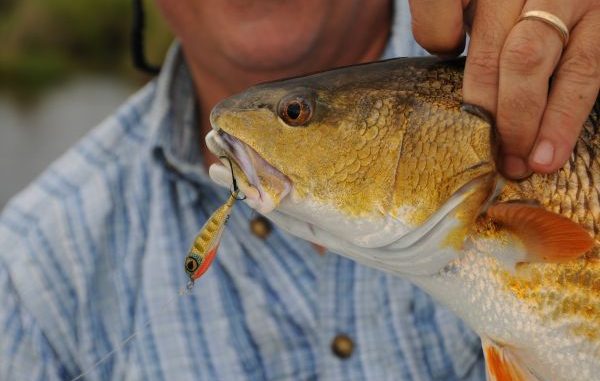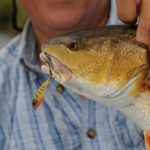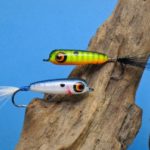
Metairie tier’s new fly taps primal behavior
I’ve been blessed to have known some of the greatest fly tiers of the modern era. Folks like George Harvey, Polly Rosborough, Mike Verduin, Chris Helms, Gary LaFontaine to name just a very few.
So take my word when I say that Kirk Dietrich ranks among the best.
Dietrich grew up around the New Orleans area, and in 1973 — at age 11 — got his first look at someone fly casting. He was so captivated by it, his dad agreed to buy him an outfit. Since then, he has rarely used other tackle.
I’ve known Kirk since 1989. At the time, he had already earned a wide reputation for his innovation at the vise.
His Kirk’s Spoon was the first spin-off of Jon Cave’s original pattern, and was so successful in catching redfish and other species that Orvis picked it up. Today Orvis sells several of his flies.
His most-popular creations after the spoonfly are the Squirrelly and the Rattle Rouser.
But his most impressive work is with poppers.
Dietrich first popularized Pete Cooper Jr.’s “Perch Float Popper” in the early ’90s by tying it at various shows and teaching it in workshops.
This simple fly is easy to construct: Cut a perch float in half, cut a slit on the halved float, slide it on a threaded hook and super glue. Then paint with a primer, add body color and eyes, and finish off with a coat of two-ton epoxy.
Sounds simple, right? Try making one, and then go to Photobucket and search for “KirkDiet” and look at some of his examples.
There’s a reason he’s a master tier, and most of us are not.
Later on, Dietrich met Walt Holman, the dean of American balsa flies. A quick study, Holman’s protégé began creating, shaping, and painting poppers and divers of museum quality in no time.
Balsa flies are different. It’s not so much tying as it is crafting. The fly can be shaped into countless forms, and then painted endless colors. Prior to painting, gluing a thin foil — such as that used on baked potatoes in restaurants — onto the balsa, and then dimpling it with a knurled object to give a fish-scale effect makes the flies look more realistic.
There are many little details with balsa that can change the flotation, action, strength and appearance of the final fly. It’s those details that keep Dietrich always thinking about the next fly or how to make a fly he created even better.
A year ago, the Metairie resident began thinking about how to give his flies more-erratic action to trigger what he calls the “predatory instinct” in a bass, redfish or speckled trout.
I got a sample of this “predatory instinct” one night when I was sitting on my back porch. Belle, my faithful collie and sometimes fishing companion, was watching a gecko crawl near the bottom of the wall. She didn’t seem too interested until the gecko leaped from the wall to a chair, then back to the wall.
On the first leap, Belle bunched up into attack position. On the second leap, she sprang several feet across the porch and pounced on the tiny lizard. Let’s just say that’s one gecko that won’t be doing any insurance commercials.
Speaking of dogs, Dietrich decided to call his new creation the “Rabid Dog.” While it has similiarities to other Zara Spook-inspired poppers, this one has two key differences.
First, it’s tied on an extra-long 6x hook. Or often an extended hook made with wire since hooks that long are nearly impossible to come by. The short body on an extra-long hook causes the popper to sit cocked at a slight angle on top the water.
As is, the Rabid Dog will dip and dive when stripped. Enough erratic movement to drive a redfish or bass angry.
But being an engineer by trade, Dietrich is always thinking of that something extra — that lagniappe — to make his flies even more enticing.
So before he adds foil, paint and epoxy to the body, he drills a tiny hole at the back, and on top the balsa body. Then he drops in a tiny split shot. This imparts more imbalance to the fly.
When the Rabid Dog is stripped, if it tips to one side, the tiny weight tips it farther. But in doing so, hydrostatic pressure builds up on the tipped side, and forces it back to an upright position and sometimes even tips it to the other side.
This “floater” dips, dives and wobbles.
To list all the steps needed to tie the Dog, or any balsa fly, would take up much of this magazine. And would likely not be as informative as watching it on Youtube, where the instructions can be found there.
As with most poppers, it’s better to make several at a time than just one. For example, by the time you finish applying the primer coat on No. 8, the coat on No. 1 is dry and ready for the next step.
Dietrich will be the first to warn you that action alone doesn’t catch fish. Recently he took his creation for another of many test runs at Bayou St. John (at least that’s what he tells his wife — that he has to go test his flies).
He started with a fire-orange color and got several looks from bass but no strikes. He switched to a blue/silver color and caught fish.
Then the bite stopped and no takers for a few hours.
He switched back to the orange and caught fish again.
Cormier’s First Law of Fly Fishing states, “Fish make the rules, humans don’t!”
At least with the Rabid Dog, the rules are tipped — erratically — in our favor.




